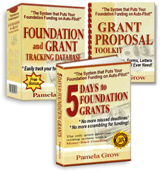![]() I recently had the opportunity to review grants for the WI Department of Instruction (DPI). Reading grants is by far the best professional development available for grant writers. For me, it revealed the secret to good grant writing. For those of you who have never had a chance to do so, I’d like to share what I learned with you.
I recently had the opportunity to review grants for the WI Department of Instruction (DPI). Reading grants is by far the best professional development available for grant writers. For me, it revealed the secret to good grant writing. For those of you who have never had a chance to do so, I’d like to share what I learned with you.
The grant reading session stretched over two days. The first morning we sat as a whole group, listening to the folks from DPI go over the history of the grant, the funding priorities, the grant application, and the review criteria that we would be using. We went through the information very thoroughly, page by page. If every grant writer were to do such careful reading before they started putting together their application, they would put themselves ahead of the competition.
We then broke off into smaller groups and were told to read one grant application as a “trial run.” We read individually, rated the grant on our own, and then came back together. As a group, we had to find consensus and decide whether the application was strong, above average, average, below average or weak. This is the process we would then use for each application.
For the next day and a half, we read grant applications on our own and then came together as a group to reach a consensus rating. As we read multiple applications, it became clear which ones were the strongest. Put simply, they were the ones that answered all the questions clearly and made it easy for us to find the information we needed. Remember this: your job as a grant writer is to make it easy for the reviewer to find the information that he or she has requested. Do not worry about impressing them with fancy prose, big words, or irrelevant data. The secret is this: give them what they want.
Here are a few ways to do that:
1. Organize your proposal in the same way that the application is organized. Answer the questions in the order that they are asked. If the reviewer criteria are provided with the application (they always are for state and federal grants), structure your answers in a way that makes it easy for a reviewer to go down the benchmark list and check them off. The moment a reviewer stats flipping back and forth between pages is the moment they lose faith in your application.
2. Follow directions. This particular grant specified that applicants should not include attachments or go over the page limits. Still, several applicants did one or the other. As reviewers, we were told to ignore any attachments and information that came after the page limits. This was in fairness to those who had followed the instructions. Those applicants who included vital information in the attachments or extra pages suffered greatly because we were not allowed to consider them.
3. Keep your tone positive. There were a few applications that talked about how desperate they were for funding and said that if they did not get this grant their program would cease to exist. I don’t know about you, but I would give money to any venture that appears to be going belly up. You may be in a desperate situation, but do not let that tone come through in your grant application. Mentioning how many other grants you have applied for and failed to receive only weakens your credibility. Instead, focus on how this money will help you accomplish your mission. Keep a positive tone. If it is too hard for you to do this, you may need to reevaluate the viability of your program altogether.
4. Include your partners in the planning of the grant application. This was a surprise to me, but it was very clear whether or not applicants had worked with the partners they listed in designing the program and writing the grant. If not, the descriptions of partners’ roles were vague. If they had included them, their specific role with a list of duties and responsibilities were in the application. This cannot be faked. Planning with partners beforehand will set you apart from other applicants.
5. When character/word limits are tight, a list is a great way to convey a lot of information in an efficient way. For proposed activities or lists of duties, narratives can get wordy and cloud the information. Lists, on the other hand, are a great way to present the information clearly. As a bonus, you use much fewer words.
Once again, I think reading grants is the best professional development out there for grant writers.
Learn more about grant writing in Katie Krueger’s online grant writing class.
This post is part of the Grant Writing article series:
1. 8 Keys to Grant Strategy Success by Robert P. Stewart
2. 20 Free Grant Writing Resources for Non-Profits by Sandra Sims
3. Building Relationships with Foundations by Sandy Rees
4. Secrets From A Grant Reviewer by Katie Krueger








